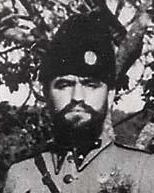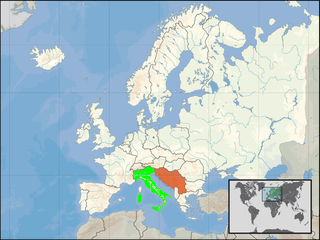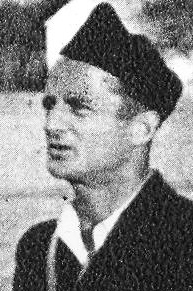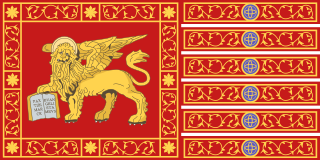
Momčilo Đujić was a Serbian Orthodox priest and Chetnik vojvoda. He led a significant proportion of the Chetniks within the northern Dalmatia and western Bosnia regions of the Independent State of Croatia (NDH), a fascist puppet state created from parts of the occupied Kingdom of Yugoslavia during World War II. In this role he collaborated extensively with the Italian and then the German occupying forces against the communist-led Partisan insurgency.

Yugoslavia was a state concept among the South Slavic intelligentsia and later popular masses from the 19th to early 20th centuries that culminated in its realization after the 1918 collapse of Austria-Hungary at the end of World War I and the formation of the Kingdom of Serbs, Croats and Slovenes. However, the kingdom was better known colloquially as Yugoslavia ; in 1929 it was formally renamed the "Kingdom of Yugoslavia".

Italy–Yugoslavia relations are the cultural and political relations between Italy and Yugoslavia in the 20th century, since the creation of Yugoslavia in 1918 until its dissolution in 1992. Relations during the interwar years were hostile because of Italian irredentist demands to Yugoslav territory, leading to Fascist Italy and the Axis Powers invading Yugoslavia during World War II. After lingering tensions after the war over the status of the Free Territory of Trieste, relations improved during the Cold War.

No. 351 Squadron RAF was a Yugoslav Partisan-manned fighter-bomber squadron of the Royal Air Force (RAF) which was operational between 13 October 1944 and 1 May 1945 during World War II. The squadron was also known by the Partisans as Second Squadron (NOVJ).

The Theme of Dalmatia was a Byzantine theme on the eastern coast of the Adriatic Sea in Southeastern Europe, headquartered at Jadera.

The Dinara Division was an irregular Chetnik formation that existed during the World War II Axis occupation of Yugoslavia that largely operated as auxiliaries of the occupying forces and fought the Yugoslav Partisans. Organized in 1942 with assistance from Ilija Trifunović-Birčanin and headed by Momčilo Đujić, the division incorporated commanders in Bosnia and Herzegovina, northern Dalmatia, and the Lika region. The division was under the control of supreme Chetnik commander Draža Mihailović and received aid from Dimitrije Ljotić, leader of the Serbian Volunteer Corps, and Milan Nedić, head of the Serbian puppet Government of National Salvation.

The 8th Dalmatian Shock Corps was a corps of the Yugoslav Partisans formed on 7 October 1943. It was formed from the 9th, 19th, 20th, and 26th Dalmatian divisions, and was named after the region of Dalmatia. Upon creation it had 13,049 soldiers. The corps operated in the Independent State of Croatia, Governorate of Dalmatia, and Adriatic Littoral, where they fought Italians, Chetniks, the Ustaše, and Germans.

The battle of Knin was a major Yugoslav Partisan operation during World War II in Yugoslavia launched by the 8th Dalmatian Corps from 7 November to 9 December 1944 with the purpose of destroying German, Ustaše and Chetnik formations in North Dalmatia and the city of Knin, then part of the Independent State of Croatia. It was the final part of the 8th Corps offensive for the liberation of Dalmatia which began on 12 September 1944. The Knin operation had three phases: Initial battles on approaches to Knin from 7 November to 25 November, main battle and liberation of Knin from 26 November to 4 December, and final battles and pursuit of retreating Axis forces to Otrić in Lika from 5 December to 9 December.

Vicko Krstulović was a Yugoslav communist revolutionary, the most prominent Partisan military commander from Dalmatia during World War II, and a post-war communist politician. He was an illegal communist activist during the 1920s and 1930s in Split at a time when communist sympathizers were brutally persecuted by the Yugoslav monarchy. As an officer in the Partisans during World War II, he was in charge of creating and organising the resistance movement in Dalmatia. In Socialist Yugoslavia, he worked in various government offices and was remembered for his work and contribution to his native Split.

Venetian Dalmatia refers to parts of Dalmatia under the rule of the Republic of Venice, mainly from the 15th to the 18th centuries. Dalmatia was first sold to Venice in 1409 but Venetian Dalmatia was not fully consolidated until 1420. It lasted until 1797, when the Republic of Venice fell to the forces of Napoleon Bonaparte and Habsburg Austria.

The Eparchy of Dalmatia is a diocese or eparchy of the Serbian Orthodox Church, having jurisdiction over the region of Dalmatia, in Croatia. Since 2017, Serbian Orthodox Bishop of Dalmatia is Nikodim Kosović.
The 4th Army of the Yugoslav Partisans was a Partisan army that operated in Yugoslavia during the last months of the Second World War.

The 3rd Assault Division was a Yugoslav Partisan division formed in Glamočko polje on 9 November 1942. Upon its formation it had around 3,200 soldiers from three brigades: 5th Proletarian Brigade, 10th Herzegovina Brigade and 1st Dalmatia Brigade. It was commanded by Pero Ćetković and its political commissar was Radomir Babić. During the Case Black, the division was disestablished after suffering heavy loses. It was re-established during the late September 1943 as a part of the 2nd Corps.

The 6th Proletarian Assault Lika Division "Nikola Tesla" was a Yugoslav Partisan division formed on 22 November 1942. It was formed from the 1st, 2nd, and 3rd Lika Brigades. On 11 November 1943, it became part of the 4th Corps and later a part of the 1st Corps. It operated in Dalmatia until November 1943 when it crossed into Bosnia, later it fought in Serbia and on the Syrmian Front. From October 1944, the 22nd Serbian Kosmaj Brigade also fought as part of the division, and in December 1944 an Artillery Brigade was formed within the division.

The 9th Dalmatia Division was a Yugoslav Partisan division formed in Imotski on 13 February 1943. Upon formation it was composed of the 3rd, the 4th and the 5th Dalmatia Brigades. The division fought NDH, Germany, Italy and Chetniks in various operations conducted by the Partisans, it played a key role in the Trieste operation. It was commanded by Ante Banina and its political commissar was Eduard Santini.

The 18th Slovenia Division was a Yugoslav Partisan division formed in Zdenska Vas on September 14, 1943. Upon formation it consisted of around 3,350 soldiers in three brigades, those being: the 8th, 9th and 10th Slovenia Brigades. The division was commanded by Rado Pehaček and its political commissar was Janez Hribar - Tone. On October 3, 1943, it became a part of the 7th Corps. The division operated in Slovenia.

The 19th North Dalmatia Division was a Yugoslav Partisan division formed in Biovičino Selo on 4 October 1943. Upon formation it had 3,559 soldiers in three brigades, those being: the 5th, 6th and 7th Dalmatia Brigades. During all of its existence it was a part of the 8th Corps. Commander of the division was Milan Kuprešanin while its political commissar was Petar Babić. The division mostly operated in Dalmatia, Lika and Bosnia.

The 22nd Serbia Division was a Yugoslav Partisan division formed on 22 May 1944 as the 2nd Serbia Division. It was formed from three brigades, those being the 8th, 10th and 12th Serbia Brigades whose total strength was around 2,000 fighters. Commander of the division was Živojin Nikolić Brka while its political commissar was Vasilije Smajević. The division fought mostly in Serbia but it also participated in battles of Syrmian Front and Final Operations.

The 26th Dalmatia Division was a Yugoslav Partisan division formed on 8 October 1943. It was formed from the 11th, 12th and 13th Dalmatia Brigades. In January 1944, the 13th Dalmatia Brigade left the division while the 1st Dalmatia Brigade joined it. The 3rd Overseas Brigade joined the division in March 1944. The division mostly operated in the Southern Dalmatia where it fought against parts of the 2nd Panzer Army, 118th Jäger Division, 7th SS Division, and 369th Infantry Division.

The 29th (Herzegovinian) Division was a Yugoslav Partisan division formed on 16 November 1943. It was formed from the 10th, 2nd and 3rd Herzegovinian Brigades which had a total strength of 1,567 fighters. Since its formation, the 29th Division was a part of the 2nd Corps.












